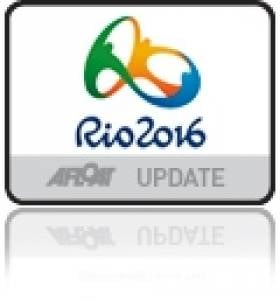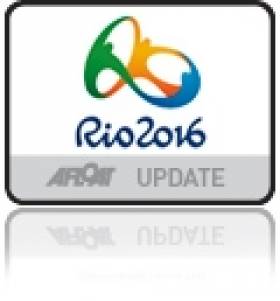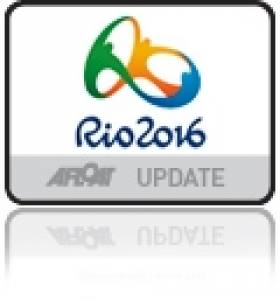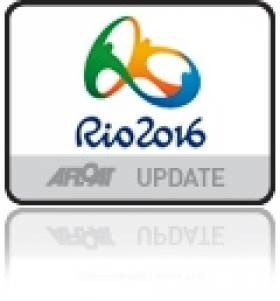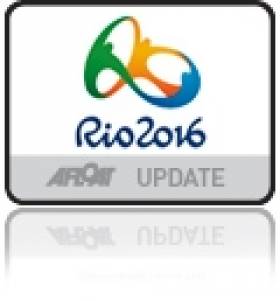Displaying items by tag: Rio 2016
'Super-Bacteria' Concern For Rio 2016 Sailing Waters
#Rio2016 - A newly discovered 'super-bacteria' could pose a serious threat to the health of sailors competing at the next Summer Olympics in Rio.
According to Reuters, scientists in the Brazilian city have found a strain of bacteria that can cause any number of internal infections – but is resistant to antibiotics.
The bacteria was discovered in samples taken from a river that feeds into the main sailing grounds for Rio 2016 at Guanabara Bay.
The latest news will be of grave concern to sailors like Annalise Murphy, James Espey, Ryan Seaton and Matt McGovern who are already headed to Rio and will frequent the city for competitions and training camps over the next 18 months leading up to the games.
It also comes after the disappointing news earlier this year that pollution issues in Rio's waters will not be solved in time for the Olympiad - a year after Irish Olympic coach Ian Barker described the city's waters as "absolutely disgusting".
Cash Injection For Ireland's Rio Olympics Campaign
#Rio2016 - Irish sailing will share in a €2 million boost from the Minister for Sport for the nation's Olympic campaign at Rio 2016.
As the Irish Examiner reports, the ISA will get a €70,000 share to fund its pre-games team base in the Brazilian host city, where the likes of already Rio-bound sailors Annalise Murphy, James Espey, Ryan Seaton and Matt McGovern will get all the training hours they need to challenge for gold.
This is on top of the €500,000 Sports Capital Programme grant to Irish sailing clubs earlier this year.
Meanwhile, Ireland's focus on sailing success at the Rio Games was confirmed with the Irish Sports Council's designation of ISA performance director James O'Callaghan as the sport's 'team leader' under overall chef de mission Kevin Kilty.
The Irish Examiner has more on the story HERE.
Irish Improve In ISAF World Rankings After Santander
#Santander2014 - With the last races sailed at the 2014 ISAF Worlds in Santander, the biggest plaudits are going to the new world champions who've seen their stock rise in the global rankings.
But they're not the only ones with reasons to celebrate, as Ireland's sailing team have added to their impressive performances in Spain last week with a strong showing in the latest world sailing tables announced today (23 September).
Not content with being Ireland's first Olympic qualifier, James Espey has jumped four places in the Men's Laser rankings from 62nd to 58th. But he's not even the biggest riser among the Irish.
That accolade goes to Laser prospect Finn Lynch, who didn't have much to write home about in Santander but still rocketed from 296th in the world to 194th: a remarkable improvement of 102 places. Well done, Finn!
Andrea Brewster and Saskia Tidey may have narrowly missed out on Olympic qualification in the 49erFX, but they've jumped two placed in the world table from 29th to 27th – not bad at all for the development duo who've only been sailing together for a year.
Holding steady, meanwhile, are Rio-bound Annalise Murphy at 18th place in the world Laser Radial rankings, and Ryan Seaton and Matt McGovern, who are just one spot off the world top 10 in the 49er class.
It wasn't the best performance for independent Irish sailor Ross Hamilton, who slipped two places from 59th to 61st in the Finn class, but he will have further opportunity to improve his position and stake claim on a coveted spot in Rio for the 2016 Olympics.
Rio 2016 Olympics Ticket Prices Announced
#Rio2016 - With Ryan Seaton and Matt McGovern, James Espey and Annalise Murphy all qualified for the next Olympic Games at the ISAF Worlds last week, Irish sailing fans will be interested to know that ticket prices for Rio 2016 have been announced.
As the Olympic Council of Ireland reports, more than half of all tickets will be sold at accessible prices in order to ensure that the event is open to everyone.
About 7.5 million tickets will be issued, and some 3.8 million of these will be available for 70 Brazilian reals – €23 at the current exchange rate - or less.
The price list is available as a PDF to read or download HERE - and sees the sailing sessions at Copacabana priced between 40 and 100 reals (€13-33).
The full Rio 2016 ticket sales programme will be unveiled in November, along with the competition schedule and details on how the public can buy tickets. Brazilian residents will be able to enter the first of two draws for tickets in March 2015.
Non-Brazilian residents will be able to apply to buy tickets in their own territories in the first half of 2015 (details to come) and then again in January 2016 in the worldwide first-come-first-served online sales phase.
James Espey Climbs The Rankings After ISAF Worlds Day 3
#Santander2014 - Not one to rest on his laurels after securing his place at the Rio Olympics – the first Irish sailor to do so – Belfast Laser helm James Espey made the most of Day 3's light winds to climb up the rankings at the ISAF Worlds in Santander.
Few fleets managed to get any racing in, and even at that there were frustrating delays before their class sprints were abandoned. But Espey remained cool and calm where many of his Gold Fleet competitors let their nerves get to them – nine disqualifications for crossing the line early was the result.
When the race did get under way, Espey sailed with the leading pack the 4-8 knot breeze, only slipping down in the second half to finish 10th, leaving him in 26th place overall – 14 places higher than where he finished yesterday.
Meanwhile, in the women's Laser Radial Gold Fleet, Annalise Murphy was unable to repeat yesterday's impressive recovery when she got caught out on the wrong side of the fleet and had to settle for 37th. The Olympic hero is now 45th overall in the 60-boat fleet.
There was no race today for Finn Lynch with the Laser Standard Bronze Fleet abandoned, though tomorrow's rest day may be rescheduled if the winds are favourable to make up for today's lost action.
Also on the water tomorrow for Team Ireland will be Ryan Seaton and Matt McGovern in the men’s 49er class, Andrea Brewster and Saskia Tidey in the female 49erFX and Ross Hamilton in the Finn fleet.
Rio 2016 Olympic Sailing Regatta Qualification System
#rio – The qualification system for the Olympic Games of the XXXI Olympiad – RIO 2016 is published by the International Sailing Federation (ISAF) and available to download here as a five page pdf document below.
#rio2016 – More than 320 sailors from 34 nations will compete at the first test event of the Rio 2016 Olympic and Paralympic Games from 2-9 August from the Marina da Gloria.
The Aquece Rio – International Sailing Regatta 2014 is set to be the largest Olympic classes sailing competition ever held in Brazil and many of the world's top competitors are ready for the test.
Organised by Rio 2016 and Confederação Brasileira de Vela (CBVela) in conjunction with the International Sailing Federation (ISAF), the regatta will test the field of play, equipment, workforce, systems and procedures two years out from the Olympic Sailing Competition.
Five race courses will be assessed during the course of the regatta with three areas – Ponte, Escola Naval and Pão de Açucar –situated inside Guanabara Bay and the other two - Copacabana and Niterói – located outside the bay in open water.
The Test Event will be the first opportunity to start developing the skills of the 1,000+ workforce who will be critical to the success of the Rio 2016 Olympic Sailing Competition. The on water race committee teams are one such group and their training programme will get underway under the guidance of International ISAF officials from Brazil and overseas.
Media coverage and results from the Aquece Rio will be delivered by the Rio 2016 team and ISAF through www.aquecerio.com/en/competicoes.php and http://www.sailing.org/2014-test-event.php
Each nation is entitled to two places per Olympic event for the Aquece Rio – International Sailing Regatta and two teams will have full squads racing on Rio's water.
The British and Brazilian teams will have 20 boats and 30 sailors competing throughout the week however the Brazilians will benefit from it being their home waters.
World #1 49erFX team Martine Grael and Kahena Kunze (BRA) will be the favourites in the 16-boat fleet having finished on the podium at 11 of 14 ISAF ranked regattas since jumping in the skiff. The pair are local to Rio but won't be taking anything for granted, "It is very hard to tell what is going to happen. We have to be prepared for everything and whatever comes, will be.
"We train here but racing is always different. I expect a low number of sailors but with a high level so it will be the perfect training session."
As Grael predicts the level is set to be high in the 49erFX fleet with 2013 World Champions Alex Maloney and Molly Meech (NZL) within the fleet. Speaking on their blog the pair said, "The main goal for the trip is to get accustomed to being in Rio, and the sailing conditions here. This competition is the first run-through event for both the organisers and sailors, and it will be great to get to know the rough course areas planned for the 2016 Olympics. After a great break, we are ready to get back into and learn as much as possible."
Strong teams from Argentina, Australia, Austria, Great Britain, Germany, Japan, Netherlands, Sweden and the USA will join the Brazilians and Kiwis on the 49erFX start line in Rio.
Fresh from 49er Open European success Peter Burling and Blair Tuke (NZL) will spearhead the 19-boat 49er fleet. The Kiwis have won five consecutive 49er regattas including two ISAF Sailing World Cup regattas, one World Championship and two Open European Championships.
The Aquece Rio – International Sailing Regatta will be their first opportunity to showcase their talent on Olympic waters but they will be joined by a small yet competitive fleet that includes London 2012 gold medallists Nathan Outteridge and Iain Jensen (AUS) and consistent British racers Dylan Fletcher and Alain Sign.
The Laser Radial fleet features 28 sailors and includes six of the world's top ten, including World #1 Marit Bouwmeester (NED).
Many of the Laser Radial competitors have Rio experience under their belt and that includes Annalise Murphy (IRL) who, like many of the competitors, isn't focused on the end result, "I am really looking forward to experiencing some proper fleet racing in Rio, I think racing two years out from the Games is going to be hugely beneficial in my preparation for the Olympics.
"I hope to get a better understanding of Rio, get a feel for the bay and the different conditions we will experience. Everything is important to get used to, the wind, the tide, the food and finding a gym.
"I came to Rio for three weeks training last year and experienced a big mix of conditions; it is pretty tidal so it is going to be a tricky event. I think the racing will be very competitive; nearly everyone is here for this regatta so it will be a very high standard. I am looking forward to going out and enjoying myself on the water."
Joining Bouwmeester and Murphy in the fleet will be World #2 and ISAF Sailing World Cup Hyeres victor Evi Van Acker (BEL), ISAF Sailing World Cup Qingdao gold medallist Dongshuang Zhang (CHN) and World Cup Miami winner Paige Railey (USA).
The Laser fleet will be the largest in Rio with 36 boats registered to race. Top competitors include home favourite and 2013 Laser World Champion Robert Scheidt (BRA), Australia's Tom Burton, World #2 Nick Thompson and strong Kiwi sailors Andy Maloney and Sam Meech.
The Nacra 17 fleet will see 16-boats on the start line and includes a number of leading teams. 2013 World Champions Billy Besson and Marie Riou (FRA) will be joined by the experienced Darren Bundock and Nina Curtis (AUS), World #2 Ben Saxton and Hannah Diamond (GBR), Franck Cammas and Sophie de Turckheim (FRA) and World #3 Thomas Zajac and Tanja Franck (AUT).
Giles Scott (GBR) is the Finn class' man of the moment having won nine of the last ten regattas. Scott has won his last five regattas and will be the one to beat in Rio but strength in depth is present throughout the fleet. Brazil's Jorge Zarif and Bruno Prada will have home water advantage whilst World #2 Bjorn Allansson (SWE), World #3 Thomas Le Breton (FRA) and the seasoned Jonathan Lobert (FRA) and Pieter Jan Postma (NED) will provide stern competition.
Aquece Rio - International Sailing Regatta 2014 is the first of two test events with the second following in 2015, provisionally scheduled for 12-22 August.
#rio2016 – Ireland's Annalise Murphy has arrived in Rio for next week's Aquece Rio - International Sailing Regatta 2014, the first test event of the Rio 2016 Olympic and Paralympic Games that takes take place from 2-9 August from the Marina da Gloria.
The Dubliner touched down in Brazil and was reunited with her boat and container that shipped to Brazil some weeks earlier. Unfortunately, her sailing gear and lost luggage has yet to be found as she posted on her facebook page.
Murphy will be one of 324 athletes from 34 nations, racing in 215 boats, it is set to be the largest Olympic classes sailing competition ever held in Brazil. Last week, the National Yacht Club sailor was crowned Women's Moth World Champion in Hayling Island.
Organised by Rio 2016 and Confederacao Brasileira de Vela (CBVela) in conjunction with the International Sailing Federation (ISAF), the regatta will test the field of play, equipment, workforce, systems and procedures two years out from the Olympic Sailing Competition.
The venue has already come in from heavy criticism from Irleland among other countries with one Irish Sailing coach branding it a 'sewer' last December.
All five proposed Olympic race course areas will be assessed during the course of the regatta. Three course areas - Ponte, Escola Naval and Pao de Acucar - are situated inside Guanabara Bay with the other two - Copacabana and Niteroi - located outside the bay in open water.
Pae de Acucar, the proposed Medal Race course area with its spectacular Rio backdrop, will be put through its paces from day one.
Come Games Time, a workforce of over 1,000 people are expected to be working on the Olympic Sailing Competition and a key objective of the Test Event is to start developing the skills of the team who will be critical to a successful regatta. The on water race committee teams are one such group and their training programme will get underway under the guidance of International ISAF officials from Brazil and overseas. More on this event here.
Meanwhile, the sailors to represent Ireland at the ISAF Sailing World Championships to be hosted in Santander, Spain from 12-21 September were announced today at a press conference in Dublin. This event will be the first opportunity to qualify Ireland for the Rio 2016 Olympic Games in the following classes:
Providence Team IRL (sailors that competed in London 2012)
49er – Ryan Seaton & Matt McGovern
Laser Radial – Annalise Murphy
Laser Standard – James Espey
ISA Development Academy (sailors in training for 2016 or 2020)
49erfx – Andrea Brewster & Saskia Tidey
Laser Standard – Finn Lynch
Also announced was that the Rio 2016 Paralympic qualifier event will take place at the IFDS World Championships in Halifax, Canada from 19-24 August. John Twomey from Kinsale will be hoping to qualify for his 11th consecutive Paralympic Games.
Providence Team IRL – Paralympic Team
Sonar (Paralympic) – John Twomey, Ian Costello & Austin O'Carroll
The Irish Sailing Team had their most successful Olympics for thirty years at London 2012 with 4th, 10th and 14th place finishes and their target is to build on this success as they commence the road to Rio 2016.
Ireland's Debut 49erFX Team Make Kiel Week Medal Race
#49er – In a certain boost to their debut season Andrea Brewster and Saskia Tidey will race in tomorrow's medal race at Kiel week regatta after five blustery qualifying races – that included a race win.
Scoring a 10th today and dropping a 13th (discarded after 5 races) Brewster and Tidey now lie eighth overall in the Eurosaf Cup event, 20–points off the overall lead. (Download results below as a pdf file).
'We are pretty thrilled with our result as we have made it into the medal race tomorrow with the top 10 boats. This will be the first medal race we have ever qualified for' Brewster wrote on Facebook tonight.
The girls medal race starts at 10am on Friday and, according to organisers is to be broadcast live HERE.
A month ago, the Royal Irish pair were forced to withdraw from the Eurosaf regatta on Lake Garda when crew Tidey was injured in a high speed capsize. Thankfully, this injury appears to be completely behind them, with this week's performance in breeze a heartening result for the Dublin Bay campaign.
Admittedly the Kiel womens' 49erfx fleet is missing both the winner and runner up from the last outing of the ISAF world Cup in Hyeres in late April but the 33–boat fleet does contain the Danish pair Ida Marie Baad Nielsen and Marie Thusgaard Olsen who took bronze on the Cote D'Azur. Also in Kiel this week are top placed Italian and Dutch crews to reinforce the point that although Kiel may not be part of ISAF's world cup circuit it can still produce a hotly contested womens skiff event.
In the mens division, Ryan Seaton and Matt McGovern, will also contest tomorrow's medal race. The Northern Ireland skiff pair won an ISAF silver medal at Hyeres World Cup Event in April and have proved quick again this week in breezy conditions. (See above vid).
More than 4,500 sailors from more than 50 nations with 1800 boats are racing off Schilksee from 21 to 29 June at the 132nd Kieler Woche, and they are fighting for titles and medals in 42 Olympic, paralympic, international and offshore classes.
Medal Race: Front Runners From Five Nations
The wind eased for the time being. At the fourth day of Kieler Woche after three days of strong winds, there was only a light breeze on the outer fjord in Kiel. But that did not really make life of the race directors and sailors easier, since the crews proceeded on their courses at a snail's pace - too slow to get a complete race program done.
On Wednesday there will be the finals of the Olympic classes sailed on short legs and three courses. At 10am the 49erFX (TV course), Laser Radial (course India) and the Nacra17 (course Juliett) will start, followed by the 49ers at 11am (TV) and the Lasers (India) and the 470s Men (Juliett) at 11:30am.
Results: Kieler Woche day 4
2.4mR: (5 races)
1. Heiko Kroger, GER, 4 points
2. Barend Kol, NED, 9
3. Helena Lucas, GBR, 15
Sonar: (5)
1. Jens Kroker / Robert Prem, Siggy Mainka, GER, 4
2. Soren Werner / Christian Bauer, Lutz Rewa, GER, 8
3. Thomas Beer / Jorg Meierdiercks, Oliver Utrata, GER, 11
49er: (7)
1. Erik Heil / Thomas Ploessel, GER, 16
2. David Evans / Ed Powys, GBR, 26
3. Jacopo Plazzi / Umberto Molineris, ITA, 26
49er FX: (5)
1. Jena Mai Hansen / Katja Salskov-Iversen, DEN, 11
2. Victoria Jurczok / Anika Lorenz, GER, 15
3. Tamara Echegayen / Berta Betanzos, ESP, 15
Nacra 17: (6)
1. Allan Norregaard / Line Just, DEN, 15
2. Vittorio Bissaro / Silvia Sicouri, ITA, 18
3. Lorenzo Bressani / Micol Giovanna, ITA, 23
Finn: (5)
1. Bjorn Allansson, SWE, 16
2. Giorgio Poggi, ITA, 16
3. Tomas Vika, CZE, 17.3
470 M: (6)
1. Panagiotis Mantis / Pavlos Kagialis, GRE, 13
2. Mathew Belcher / Will Ryan, AUS, 17
3. Ferdinand Gerz / Oliver Szymanski, GER, 18
470 W: (6)
1. Lara Vadian / Jolanta Opar, AUT, 10
2. Annina Wagner / Elisabeth Panuschka, GER, 12
3. Alisa Kirilyuk / Liudmila Dmitrieva, RUS, 18
Laser Standard: (9)
1. Philipp Buhl, GER, 29
2. Karl-Martin Rammo, EST, 33
3. Tobias Schadewaldt, GER, 40
Laser Radial: (4)
1. Lisa Fasselt, GER, 10
2. Tatiana Drozdovskaya, BLR, 10
3. Pauline Liebig, GER, 21
Melges 24: (7)
1. Riccardo Simoneschi / Enrico Fonda, Stefano Orlandi, Federico Buscaglia, Lucia Giorgetti, ITA, 8
2. Kim Christensen / Peter Jakobsen, Mads Holmer, Jamie Lea, DEN, 11
3. John Den Engelsman / Rikst Dijkstra, Willem Jan Van Dort, Rinse Ubbink, Irena Doets, NED, 27
Platu 25: (7)
1. Gordon Nickel / Morten Nickel, Nils-Mathes Fiege, Nils Merten Farber, Sebastian Roske, GER, 9
2. Ingo Lochmann / Christian Maedel, Matthias Kruger, Jens Steinborn, Timo Chorrosch, GER, 21
3. Eiko Powilleit / Robert Heymann, Frank Barownick, Thomas Schuler, Andreas Gluschke, GER, 22
J/70: (7)
1. Claas Lehmann / Marc-Daniel Mohlmann, Bjorn Athmer, Valentin Zeller, GER, 14
2. Wouter Kollmann / Kim Platteeuw, Gilbert Figaroa, Wick Hillege, NED, 20
3. Michael Ilgenstein / Finn Mrugalla, Jan-Ole Burzinski, Terje Klockemann, GER, 21
J/80: (7)
1. Martin Menzner / Frank Lichte, Mika Rolfs, Carsten Hopp, GER, 6
2. Soren Hadeler / Peer Schickedanz, Henning Buchmann, Simon Bodermann, GER, 17
3. Hauke Kruss / Ole Sartori, Rune Schytt-Nielsen, Peer Kolberg, GER, 20
SB20: (7)
1. Alexey Murashkin / Kirill Frolov, Egor Ignatenko, RUS, 9
2. Marco Van Driel / Joost Assmann, Martijn Worseling, NED, 13
3. Leonid Altukhov / Igor Matviienko, Ruslana Taran, RUS, 19
Albin Express: (7)
1. Arne K Larssen / Merle Risy, Steffen Muhlenkamp, Sebastian Hantke, Nils Albrecht, SWE, 7
2. Andreas Pinnow / Jan Heinecke, Frieder Neu, Malte Nathke, Julian Heller, GER, 11
3. Mark Schuerch / Dirk Hornschuh, Soren Hesse, Raoul Kubler, GER, 28
Offshore:
ORC I IDM (6):
1. Platoon, Harm Muller-Speer, GER, 7.5
2. Desna, Sven Wackerhagen, GER, 21.5
3. Oxygen, Morton Ulrikkeholm, NOR, 22
ORC II IDM (6):
1. Rockall IV, Christopher Opielok, HKG, 11
2. X-Day, Niels Gauter, GER, 20
3. Sirena, Peter Buhl, DEN, 23
ORC III/IV IDM (6):
1. Sportsfreund, Axel Seehafer, GER, 10
2. Solconia, Max Gurgel, GER, 11
3. Patent3, Jens Tschentscher, GER, 13
#Rio - Rio de Janeiro's dirty water problem will not be solved by the time the Brazilian city hosts the next summer Olympic Games in 2016, as The New York Times reports.
Despite promises by city officials as far back as 2009 that Guanabara Bay and Rio's waterways would be cleaned of sewage and refuse by at least 80%, a recent letter obtained by the Associated Press news agency claims that at the current funding rate it would take a decade to reduce pollution to acceptable levels.
The letter from the office of Rio's state environment secretary to Sports Minister Aldo Rebelo is backed up by an AP analysis of national statistics which shows pollution in the city's waters is far above Brazil's national limits, which are themselves regarded as less stringent when compared to European standards.
As reported last December on Afloat.ie, Irish Olympic sailing coach branded the future Olympic waters of Rio as "absolutely disgusting", comparing Guanabara Bay to a "sewer" where training sailors had to repeatedly stop to disentangle refuse from their rudders.
State authorities are now asking for $70 million to build new river water treatment units to filter out waste before it reaches the bay, though it's expected to reduce current pollution levels by just 50% in time for the first sailing events.
The New York Times has more on the story HERE.




























